Rationale of the Week | I am non-binary. Will having diabetes impact my sexual health?

We quizzed test takers on diabetes and sexual health. 73% of respondents, chose the best answer. Since we are addressing diabetes distress in our December newsletter, we thought this would be the right time to explore this topic in more depth. As we all know, sexual health and well being are interrelated. We want to share this important info on discussing sexual well being, so you can pass it on to people living with diabetes and your colleagues.
Before we start though, if you don’t want any spoilers and haven’t tried the question yet, you can answer below: Answer Question
Question: JR is a 33-year-old who is non-binary and was recently diagnosed with type 2 diabetes. During your assessment, JR asks if diabetes can affect their sexual health.
What is the best response?
Answer Choices:
- That is a complicated question that is best discussed with your provider
- Here is a pamphlet on LGBTQ+ issues and sexuality that explains the most frequently asked questions.
- According to the data, there is a higher rate of erectile dysfunction in people living with diabetes.
- There is a relationship between elevated blood sugars and sexual health.
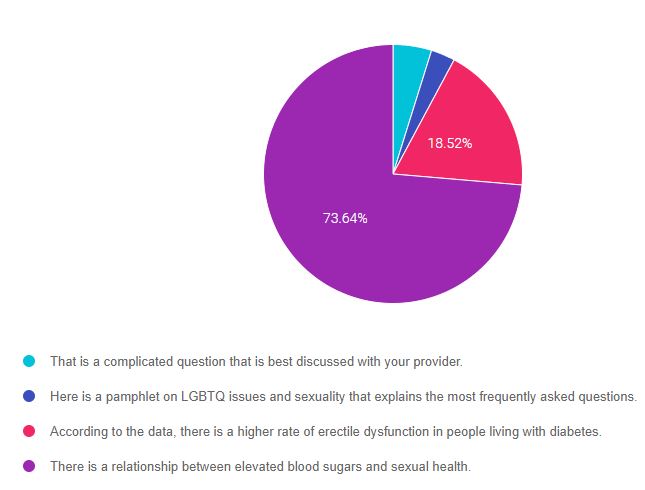
As shown above, the most common choice was option 4, the second most common answer was option 3, then option 1, and finally option 2.
Getting to the Best Answer and Providing Inclusive Care
If you are thinking about taking the certification exam, providing person-centered care is at the heart of the exam. Being familiar with diabetes care across the lifespan and for diverse populations is also really important. This practice test question will set you up for success. Test writers anticipate possible answers based on the details in the question. They will wave those “juicy answers” that seem so familiar to you, right under your nose. Your job is to weed through the to choose the BEST answer based on the person’s characteristics.
Inclusive Care and Gender Identity
In this Question of the week, we are working with JR who identifies as non-binary. Let’s take a moment and address how this might impact our approach to care.
First, since JR let’s us know that they are non-binary, what does that mean?
Nonbinary describes someone whose gender doesn’t fit within the gender binary of a man or a woman. “Nonbinary” is an umbrella term that expresses a wide range of gender identities; other terms someone may use to describe themselves is genderqueer or gender non-conforming, among others. It is important to check in with each person and ask them how they identify. One way of doing this is to introduce yourself, along with your pronouns, and then ask what pronouns the other person uses, as in the example below.
“Hello, my name is Beverly and I go by ‘she, her’ pronouns. What pronouns do you use?”
or
“How would you like me to refer to you?”
By paying careful attention to each person’s experience from the moment they walk in the door until we say goodbye, we can find ways to create a more inclusive environment. This awareness of the details, such as inclusive gender questions on intake forms or gender-neutral signage on the bathrooms, are great first steps to show your care and respect for those you work with.
Next, what do we know about providing care to members of the lesbian, gay, bisexual, transgender, and queer (LGBTQ+) community with diabetes?
Studies have shown that those who are LGBTQ+ are subject to unique health disparities and worse health outcomes than their heterosexual counterparts, which has clinical relevance in the delivery of diabetes care and education. Diabetes care and education specialists are in a pivotal position to advocate for this medically underserved and vulnerable population, to make sure they get the best possible care.
Lastly, JR wants to know how diabetes will affect their sexual health.
At this juncture, we may provide a general overview of how elevated blood sugars can affect blood vessel health and cause nerve damage, that may impact their sexual function over time (such as difficulty feeling pleasure or achieving an orgasm). Then we might ask if they have any particular questions. Our willingness to explore this sensitive topic free of judgment will be very meaningful. And, it’s okay if this feels new and uncomfortable.
“We all have our own personal experiences and internalized biases which impact the care we deliver. Our job is to practice cultural humility by checking in with our biases so they do not interfere with helping someone find a path to thriving with diabetes. It can feel uncomfortable at first, but as we take the time to expand our knowledge about others, it will feel more comfortable”
And just know, it takes time to get up to speed. I’d encourage readers to check out the ADCES handout below and watch this funny video clip that a colleague sent me, “What “The Sex Talk” Looks Like Now, by Alternatino. This video made me crack up and appreciate the nuance of all the terms. Thanks so much, for your willingness to consider this topic. I truly hope you find it helpful in improving in delivery of care.
Getting to the Best Answer
Answer 1 is incorrect. 4.82% chose this answer, “That is a complicated question that is best discussed with your provider.” Even though sexual health may not be our area of expertise, we can certainly provide a general answer and explore their particular questions. Of course, if a question is beyond our knowledge, referring back to the provider would be best.
Answer 2 is incorrect. 3.01% of you chose this answer, “Here is a pamphlet on LGBTQ+ issues and sexuality that explains the most frequently asked questions.” This is not the best answer, because it doesn’t address the question the person is asking. JR wants to know how diabetes can affect their sexual health, not the relationship between LGBTQ+ and sexuality.
Answer 3 is incorrect. 18.52% of respondents chose this answer, “According to the data, there is a higher rate of erectile dysfunction in people living with diabetes.” It is true that up to 50% of men with diabetes experience erectile dysfunction. However, we are not sure of JR’s sex assigned at birth, so this answer may not apply to JR. Instead, we could provide a general overview of how elevated blood sugars can affect blood vessel health and cause nerve damage, that may impact their sexual function over time (such as difficulty feeling pleasure or achieving an orgasm).
Finally, Answer 4 is correct. 73.64% chose this answer, “There is a relationship between elevated blood sugars and sexual health.” YES. This is the BEST answer. And, we might then ask if they have any particular questions.
We hope you appreciate this week’s rationale! Thank you so much for taking the time to answer our Question of the Week and participate in this important learning activity!
Resources for Inclusive Care
ADCES Inclusive Care for LGBTQ+ People with Diabetes Handout – this handout provides definitions, terms to avoid, and a cultural competency checklist to help you move towards improving inclusivity within your practice.
All Gender Restroom Sign PDF
A Guide To Gender Identity Terms by NPR – A glossary for gender identity terms to use more inclusive language.
Diabetes Prevention and Management for LGBTQ+ People Handout – this handout includes research of diabetes within the LGBTQ+ community, along with clinical considerations, programs, and resources for diabetes educators to use within their practice.
Policies on Lesbian, Gay, Bisexual, Transgender & Queer (LGBTQ+) issues – this resource by the American Medical Association lists all the current healthcare policies in place for the LGBTQ+ community.
Helio’s LGBTQ+ Health Updates Resource Center – this is a “collection of news articles and features that provide the latest information on the unique health needs of individuals in the LGBTQ+ community.”
Want to learn more about this topic?
Enroll in our Level 2 | Assessing and Promoting Well-Being: From Population Health to a Person-Centered Approach Standards | 1.5 CEs
Annual Update Airs Live on December 21st at 11:30 am PST

This presentation will include the latest information on Social Determinants of health, assessment strategies, and approaches. We will explore the psychosocial issues that can discourage individuals from adopting healthier behaviors and provides strategies to identify and overcome these barriers. Life studies are used to apply theory to real-life situations. A great course for anyone in the field of diabetes education or for those looking for a new perspective on assessment and coping strategies.
Objectives:
- State strategies to assess and address social determinants of health
- Discuss health care delivery systems using a person-centered approach
- List screening tools that can help detect distress, depression, trauma, and cognitive decline
- Describe psycho-social and emotional barriers to diabetes self-management
- Provide strategies for healthcare professionals to identify and overcome barriers to self-care
Intended Audience: A great course for healthcare professionals in the field of diabetes education looking for a straightforward explanation of identification and treatment of hyperglycemic crises.
Instructor: Beverly Thomassian RN, MPH, CDCES, BC-ADM is a working educator and a nationally recognized diabetes expert.
Enroll in our entire Level 2 – Standards of Care to join us for the below 2022 Live Webinar Updates. All courses air at 11:30 a.m. (PST)
- December 15, 2021 – Hyperglycemic Crises, DKA & HHS Standards | 1.0 CE
- December 21, 2021 – Assessing and Promoting Well-Being: From Population Health to a Person-Centered Approach Standards | 1.5 CEs
- February 3, 2022 – ADA Standards of Care | 2.0 CEs
- March 24, 2022 – Meds Management for Type 2 – 1.5 CEs
- March 29, 2022 – Lower Extremity Assessment 1.5 CEs
- April 26, 2022 – Microvascular Complications, Eye, Kidney Nerve Disease 1.5 CEs
- April 28, 2022 – Critical Assessment of Diabetes Patient 2.0 CEs
- May 10, 2022 – Cardiovascular Disease and Diabetes Standards 1.5 CEs
- May 12, 2022 – Older Adults and DIabetes 1.5 CEs
- May 17, 2022 – Tots to Teens – Diabetes Standards 1.5 CEs
- May 19, 2022 – Pregnancy and Diabetes 1.5 CEs
- May 26, 2022 – Hospital and Hyperglycemia 1.5 CEs
- July 21, 2022 – Setting up a Successful Diabetes Program 1.5 CEs
All hours earned count toward your CDCES Accreditation Information
Sign up for Diabetes Blog Bytes – we post one daily Blog Byte from Monday to Friday. And of course, Tuesday is our Question of the Week. It’s Informative and FREE! Sign up below!
[yikes-mailchimp form=”1″]The use of DES products does not guarantee the successful passage of the CDCES exam. CBDCE does not endorse any preparatory or review materials for the CDCES exam, except for those published by CBDCE.
Rationale of the Week | Who is struggling with Diabetes Distress?

Our November 30th Question of the week quizzed test takers on Diabetes Distress. 75% of respondents, chose the best answer, which is awesome. Providing person centered care and assessing for diabetes distress are both critically important knowledge points for clinical practice and also for the certification exams.
Before we start though, if you don’t want any spoilers and haven’t tried the question yet, you can answer below: Answer Question
Question:
About 30% of people living with type 1 diabetes experience diabetes distress.
Which of the following statements reflects someone struggling with diabetes distress?
Answer Choices:
- I just can’t keep up with all this diabetes self-care stuff.
- I am having trouble with carbohydrate counting.
- I just don’t want to get out of bed in the morning.
- I don’t want to wear a diabetes bracelet or necklace.
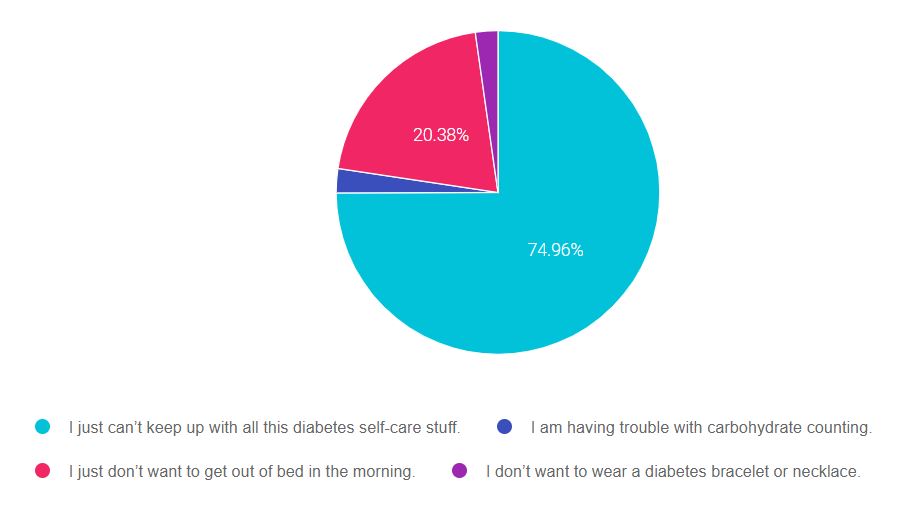
As shown above, the most common choice was option 3, the second most common answer was option 2, then option 4, and finally option 1.
Getting to the Best Answer
Answer 1 is correct. 74.96% chose this answer, “I just can’t keep up with all this diabetes self-care stuff.” Yes, GREAT JOB. When diabetes self-care all starts feeling like it’s too much or like it’s out of control, that’s when we might say a person is experiencing diabetes distress. Regimen distress is the most common area that people with diabetes come up against. Please see our blog on How to Identify Diabetes Distress and Burnout for information on how to help with diabetes distress.
Answer 2 is incorrect. 2.42% of you chose this answer, “I am having trouble with carbohydrate counting.” This comment indicates a common knowledge gap that can be addressed through providing resources and carb counting information and does not indicate distress.
Answer 3 is incorrect. 20.38% of respondents chose this answer, “I just don’t want to get out of bed in the morning.” If a person with diabetes makes this statement, we would be concerned that they are grappling with more than distress. This comment would prompt us to screen for depression. Please see this link to download the Diabetes Distress Scale and other psychosocial screening tools.
Finally, Answer 4 is incorrect. 2.25% chose this answer, “I don’t want to wear a diabetes bracelet or necklace.” Although we recommend that people taking insulin wear diabetes identification in case of emergency, it is not mandatory and they can chose not to wear one. This comment alone does not indicate diabetes distress.
We hope you appreciate this week’s rationale! Thank you so much for taking the time to answer our Question of the Week and participate in this fun learning activity!
Please see our blog on How to Identify Diabetes Distress and Burnout for more information.
Please see this link to download the Diabetes Distress Scale and other psychosocial screening tools.
Want to learn more about this topic?
Enroll in our Level 2 | Assessing and Promoting Well-Being: From Population Health to a Person-Centered Approach Standards | 1.5 CEs
Annual Update Airs Live on December 21st at 11:30 am PST

This presentation will include the latest information on Social Determinants of health, assessment strategies, and approaches. We will explore the psychosocial issues that can discourage individuals from adopting healthier behaviors and provides strategies to identify and overcome these barriers. Life studies are used to apply theory to real-life situations. A great course for anyone in the field of diabetes education or for those looking for a new perspective on assessment and coping strategies.
Objectives:
- State strategies to assess and address social determinants of health
- Discuss health care delivery systems using a person-centered approach
- List screening tools that can help detect distress, depression, trauma, and cognitive decline
- Describe psycho-social and emotional barriers to diabetes self-management
- Provide strategies for healthcare professionals to identify and overcome barriers to self-care
Intended Audience: A great course for healthcare professionals in the field of diabetes education looking for a straightforward explanation of identification and treatment of hyperglycemic crises.
Instructor: Beverly Thomassian RN, MPH, CDCES, BC-ADM is a working educator and a nationally recognized diabetes expert.
Enroll in our entire Level 2 – Standards of Care to join us for the below 2022 Live Webinar Updates. All courses air at 11:30 a.m. (PST)
- December 15, 2021 – Hyperglycemic Crises, DKA & HHS Standards | 1.0 CE
- December 21, 2021 – Assessing and Promoting Well-Being: From Population Health to a Person-Centered Approach Standards | 1.5 CEs
- February 3, 2022 – ADA Standards of Care | 2.0 CEs
- March 24, 2022 – Meds Management for Type 2 – 1.5 CEs
- March 29, 2022 – Lower Extremity Assessment 1.5 CEs
- April 26, 2022 – Microvascular Complications, Eye, Kidney Nerve Disease 1.5 CEs
- April 28, 2022 – Critical Assessment of Diabetes Patient 2.0 CEs
- May 10, 2022 – Cardiovascular Disease and Diabetes Standards 1.5 CEs
- May 12, 2022 – Older Adults and DIabetes 1.5 CEs
- May 17, 2022 – Tots to Teens – Diabetes Standards 1.5 CEs
- May 19, 2022 – Pregnancy and Diabetes 1.5 CEs
- May 26, 2022 – Hospital and Hyperglycemia 1.5 CEs
- July 21, 2022 – Setting up a Successful Diabetes Program 1.5 CEs
All hours earned count toward your CDCES Accreditation Information
Sign up for Diabetes Blog Bytes – we post one daily Blog Byte from Monday to Friday. And of course, Tuesday is our Question of the Week. It’s Informative and FREE! Sign up below!
[yikes-mailchimp form=”1″]The use of DES products does not guarantee the successful passage of the CDCES exam. CBDCE does not endorse any preparatory or review materials for the CDCES exam, except for those published by CBDCE.
Rationale of the Week | 1923 Noble Recipients for Discovery of Insulin?

Our November 23rd Question of the week quizzed test takers on the Nobel Prize insulin. 34% of respondents, chose the best answer. We are excited to share this info about the discovery of insulin with you.
Before we start though, if you don’t want any spoilers and haven’t tried the question yet, you can answer below: Answer Question
Question:
In 1923, the Nobel Prize in Physiology or Medicine was awarded for the discovery of insulin.
Which group of scientists were the recipients of the award?
Answer Choices:
- Dr. Banting and Dr. Best
- Dr. Collip, Dr. Banting and Dr. Best
- Dr. Banting, Dr. Collip, Dr. Macleod, Dr. Best
- Dr. Banting and Dr. Macleod
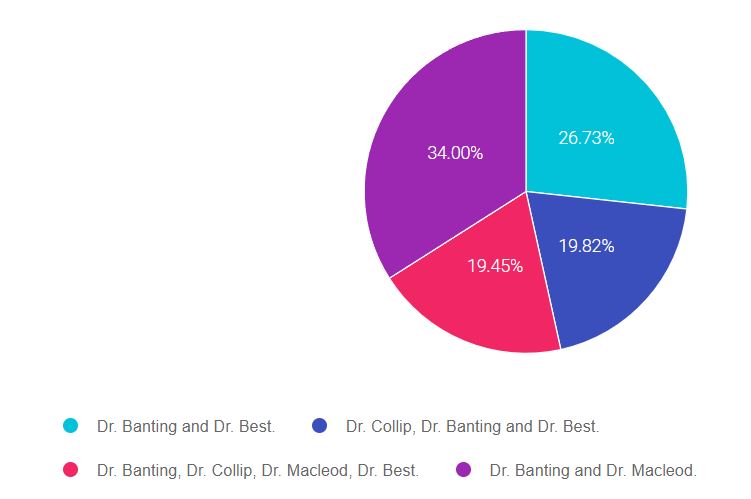
As shown above, the most common choice was option 3, the second most common answer was option 2, then option 4, and finally option 1.
Discovery of Insulin Nobel Prize 1923

The Nobel Prize in Physiology or Medicine 1923 was awarded jointly to Frederick Grant Banting and John James Rickard Macleod “for the discovery of insulin.”
According to the summary at the Nobel Prize Website – Previous doctors realized that diabetes is caused by a lack of insulin, which is formed in parts of the pancreas but could not prove it. Frederick Banting suspected that another substance formed in the pancreas, trypsin, broke down the insulin.
In John MacLeod’s laboratory in 1921, Frederick Banting and Charles Best treated dogs so that they no longer produced trypsin. Insulin could then be extracted and used to treat diabetes. A short while later, Dr. Collip made a breakthrough in purifying the extract, using alcohol in slightly over 90 percent concentration to precipitate out the active ingredient (insulin).
Although Dr. Banting, Dr. Collip, Dr. Macleod, and Dr. Best were all involved in the discovery of insulin, only Dr. Banting and the lab director, Dr. Macleod received the official Nobel prize for Medicine.
Getting to the Best Answer
Answer 1 is incorrect. 26.73% chose this answer, “Dr. Banting and Dr. Best.” Credited for their experiments on dogs at the University of Toronto in 1921 that eventually led to the discovery of insulin.
Answer 2 is incorrect. 19.82% of you chose this answer, “Dr. Collip, Dr. Banting, and Dr. Best”. Although Dr. Collip made a breakthrough in purifying the extract, using alcohol in slightly over 90 percent concentration to precipitate out the active ingredient (insulin), he, along with Best, was not recognized with a Nobel Prize.
Answer 3 is incorrect. 19.45% of respondents chose this answer, “Dr. Banting, Dr. Collip, Dr. Macleod, Dr. Best” All four of these physicians played a major part in the discovery and availability of insulin, but only Dr. Banting and Dr. Maccleod were awarded the Nobel prize.
Finally, Answer 4 is correct. 34% chose this answer, “Dr. Banting and Dr. Macleod” YES, GREAT JOB.
The Nobel Prize in Physiology or Medicine 1923 was awarded jointly to Frederick Grant Banting and John James Rickard Macleod “for the discovery of insulin.” According to the summary at the Nobel Prize Website – In John MacLeod’s laboratory in 1921, Frederick Banting and Charles Best treated dogs so that they no longer produced trypsin. Insulin could then be extracted and used to treat diabetes.
We hope you appreciate this week’s rationale! Thank you so much for taking the time to answer our Question of the Week and participate in this fun learning activity!
Want more practice questions? Enroll in our
Test Taking Practice Exam Toolkit Webinar
20 Sample Practice Questions
You are invited to join Coach Beverly for this FREE Webinar. And, if you want to have access to an additional 220+ sample practice online questions, you can purchase the complete Test Taking Toolkit.
For many of us, taking the certification exam is a nerve-wracking process.
During this webinar, Coach Beverly will help you transform your nervousness into focused energy that will help you succeed. She will provide test-taking tips based on her experience taking the certification exam six times.
2 Ways to Join Test Taking Webinar
Watch Webinar for FREE
This includes a review of 20 sample test questions with test-taking strategies. This does not include access to the recorded webinar or the practice questions.
Purchase for $49
This includes access to the recorded version of this webinar on your Online University Student Portal.
Plus, the Test Taking Toolkit provides you with over 220 sample online practice questions, simulating the exam experience. A perfect way to assess your knowledge and create a focused study plan, while increasing your test-taking confidence.
Don’t worry if you can’t make it live.
Your registration guarantees access to the recorded version.
Sign up for Diabetes Blog Bytes – we post one daily Blog Byte from Monday to Friday. And of course, Tuesday is our Question of the Week. It’s Informative and FREE! Sign up below!
[yikes-mailchimp form=”1″]Accreditation: Diabetes Education Services is an approved provider by the California Board of Registered Nursing, Provider 12640, and Commission on Dietetic Registration (CDR), Provider DI002. Since these programs are approved by the CDR it satisfies the CE requirements for the CDCES regardless of your profession.*
The use of DES products does not guarantee the successful passage of the CDCES exam. CBDCE does not endorse any preparatory or review materials for the CDCES exam, except for those published by CBDCE.
Rationale of the Week | Cost of the Insulin Patent?

This month, we are quizzing test takers on the history of diabetes. Our November 16th Question of the week quizzed test takers on the cost of the insulin patent. 74% of respondents, chose the best answer. We are excited to share this info with you in celebration of National Diabetes Month.
Before we start though, if you don’t want any spoilers and haven’t tried the question yet, you can answer below: Answer Question
Question:
On January 23rd, 1923, Dr.’s Banting, Best, and Collip were awarded the patent for insulin.
How much did Banting, Best, and Collip each charge the University of Toronto for their share of the insulin patent?
Answer Choices:
- They sold the patent for insulin for one million dollars to be divided by the 3 patent owners.
- They retained the patent for insulin to ensure exclusive rights.
- They sold the patent for insulin for $1 each.
- They sold the patent for insulin to pharmaceutical companies for an undisclosed amount.
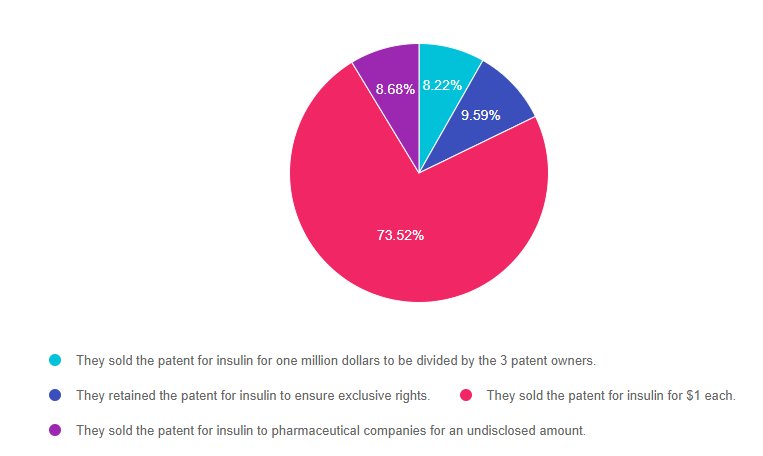
As shown above, the most common choice was option 3, the second most common answer was option 2, then option 4, and finally option 1.
Price of the Insulin Patent
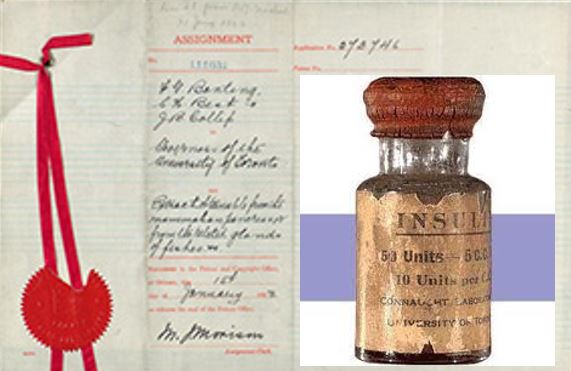
On January 23rd, 1923 Banting, Best, and Collip were awarded the American patents for insulin. They sold the patent to the University of Toronto for $1 each. Banting notably said: “Insulin does not belong to me, it belongs to the world.” His desire was for everyone who needed access to it to have it.
In order for the insulin to be mass-produced and widely available, the pharmaceutical company Eli Lilly and Co. were given the right to do so. Currently, Eli Lilly, Sanofi, and Novo Nordisk are the major insulin producers. Insulin is no longer extracted from beef and pork pancreases. Now companies use E. coli and yeast to produce insulin through recombinant DNA therapy.
With insulin patents expiring, we are now seeing the approval of biosimilar insulins that come with lower price tags. This lower-cost insulin keeps Dr. Banting’s dream alive, which is to make insulin a gift that belongs to the world.
Answer 1 is incorrect. 8.22% chose this answer, “They sold the patent for insulin for one million dollars to be divided by the 3 patent owners.”
Answer 2 is incorrect. 9.59% of you chose this answer, “They retained the patent for insulin to ensure exclusive rights.”
Answer 3 is correct. 73.52% of respondents chose this answer, “They sold the patent for insulin for $1 each.” YES, GREAT JOB. This is the BEST ANSWER!
Finally, Answer 4 is incorrect. 8.68% chose this answer, “They sold the patent for insulin to pharmaceutical companies for an undisclosed amount.”
We hope you appreciate this week’s rationale! Thank you so much for taking the time to answer our Question of the Week and participate in this fun learning activity!
Want more practice questions? Enroll in our
Test Taking Practice Exam Toolkit Webinar
20 Sample Practice Questions
Join us live June 30, 2022, for live webinar 2022 updates
You are invited to join Coach Beverly for this FREE Webinar. And, if you want to have access to an additional 220+ sample practice online questions, you can purchase the complete Test Taking Toolkit.
For many of us, taking the certification exam is a nerve-wracking process.
During this webinar, Coach Beverly will help you transform your nervousness into focused energy that will help you succeed. She will provide test-taking tips based on her experience taking the certification exam six times.
2 Ways to Join Test Taking Webinar
Watch Webinar for FREE
This includes a review of 20 sample test questions with test-taking strategies. This does not include access to the recorded webinar or the practice questions.
Purchase for $49
This includes access to the recorded version of this webinar on your Online University Student Portal.
Plus, the Test Taking Toolkit provides you with over 220 sample online practice questions, simulating the exam experience. A perfect way to assess your knowledge and create a focused study plan, while increasing your test-taking confidence.
Don’t worry if you can’t make it live.
Your registration guarantees access to the recorded version.
Sign up for Diabetes Blog Bytes – we post one daily Blog Byte from Monday to Friday. And of course, Tuesday is our Question of the Week. It’s Informative and FREE! Sign up below!
[yikes-mailchimp form=”1″]Accreditation: Diabetes Education Services is an approved provider by the California Board of Registered Nursing, Provider 12640, and Commission on Dietetic Registration (CDR), Provider DI002. Since these programs are approved by the CDR it satisfies the CE requirements for the CDCES regardless of your profession.*
The use of DES products does not guarantee the successful passage of the CDCES exam. CBDCE does not endorse any preparatory or review materials for the CDCES exam, except for those published by CBDCE.
Rationale of the Week | What does “Diabetes Mellitus” really mean?

This month, we are quizzing test takers on the history of diabetes. Our November 9th Question of the week quizzed test takers on Diabetes Mellitus. 49% of respondents, chose the best answer. We are excited to share this info with you in celebration of National Diabetes Month.
Before we start though, if you don’t want any spoilers and haven’t tried the question yet, you can answer below: Answer Question
Question:
The term diabetes mellitus is derived from Greek and Latin languages, with roots dating back to the Greek physician Demetrius of Apamea in 129-199 AD.
Which is the most accurate translation of the term diabetes mellitus in English?
Answer Choices:
- Passing through of honey or sweetness.
- Siphoning of sugared urine.
- Wasting disease due to sweetness.
- Evil urinating disease.
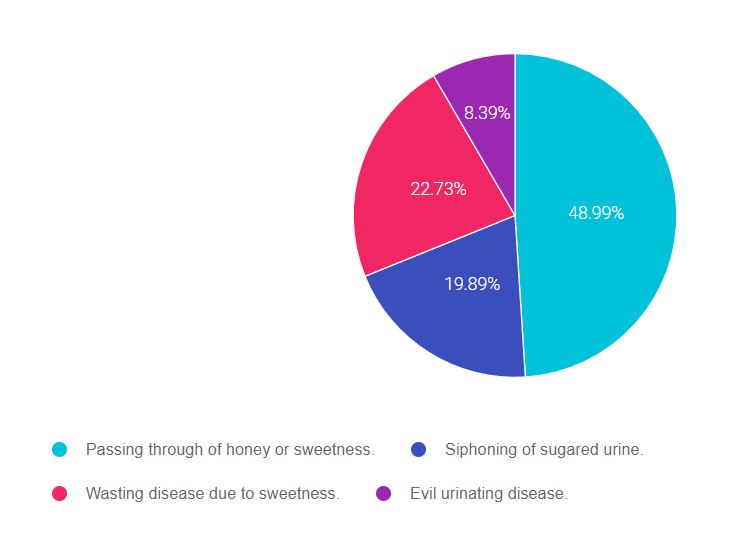
As shown above, the most common choice was option 1, the second most common answer was option 3, then option 2, and finally option 4.
Getting to the Best Answer
If you are thinking about taking the certification exam, this practice test question will set you up for success. Test writers anticipate possible answers based on the details in the question. They will wave those “juicy answers” that seem so familiar to you, right under your nose. Your job is to weed through, eliminate FALSE answers and then choose the BEST answer.
A short history of the evolution of the term “Diabetes mellitus“
The ancient Egyptians described clinical features of diabetes over 3000 years ago. Indian physicians called it madhumeha (‘honey urine’) because it attracted ants.
However, the term “diabetes” (Greek for ‘siphon’) was first used by Greek physician Demetrius of Apamea in 129-199 AD. The findings of sweet urine and blood was first noticed by ancient Indians. A few thousand years later, the Latin word “mellitus” (‘sweet like honey’) was coined by the British Surgeon-General, John Rollo in 1798.
History of the Islets and Insulin:
Paul Langerhans, 22 and working on his medical doctorate in 1869, identified the beta cells that came to be known as the ‘islets of Langerhans’. The name insulin was based on the secretions of the islets (Latin, insula = island). The term insulin was coined in 1909 and 1910, individually by de Mayer and Schaefer, respectively. Read more in this article, The History of Diabetes Mellitus, 2013 by Ritu Lakhtakia.
Answer 1 is correct. 48.99% chose this answer, “Passing through of honey or sweetness.” YES, GREAT JOB! The term “diabetes” is Greek for ‘siphon or passing through and the “mellitus” is Latin for “sweet like honey”.
Answer 2 is incorrect. 19.89% of you chose this answer, “Siphoning of sugared urine.” This is a juicy answer, but there is no Latin or Greek word for “urine” in the term “diabetes mellitus”.
Answer 3 is incorrect. 22.73% of respondents chose this answer, “Wasting disease due to sweetness.” Another juicy answer, but there is no Latin or Greek word for “wasting disease” in the term diabetes mellitus.
Finally, Answer 4 is incorrect. 8.39% chose this answer, “Evil urinating disease.” Some people might favor this term, but the term “diabetes mellitus” only describes the passing through of honey as a medical observation. There is no judgment associated with it.
Want to learn more about this fascinating topic? Read more in this article, The History of Diabetes Mellitus, 2013 by Ritu Lakhtakia.
We hope you appreciate this week’s rationale! Thank you so much for taking the time to answer our Question of the Week and participate in this fun learning activity!
Want more practice questions? Enroll in our
Test Taking Practice Exam Toolkit Webinar
20 Sample Practice Questions
Join us live December 16, 2021, for live webinar 2022 updates

You are invited to join Coach Beverly for this FREE Webinar. And, if you want to have access to an additional 220+ sample practice online questions, you can purchase the complete Test Taking Toolkit.
For many of us, taking the certification exam is a nerve-wracking process.
During this webinar, Coach Beverly will help you transform your nervousness into focused energy that will help you succeed. She will provide test-taking tips based on her experience taking the certification exam six times.
2 Ways to Join Test Taking Webinar
Watch Webinar for FREE
This includes a review of 20 sample test questions with test-taking strategies. This does not include access to the recorded webinar or the practice questions.
Purchase for $49
This includes access to the recorded version of this webinar on your Online University Student Portal.
Plus, the Test Taking Toolkit provides you with over 220 sample online practice questions, simulating the exam experience. A perfect way to assess your knowledge and create a focused study plan, while increasing your test-taking confidence.
Don’t worry if you can’t make it live.
Your registration guarantees access to the recorded version.
Sign up for Diabetes Blog Bytes – we post one daily Blog Byte from Monday to Friday. And of course, Tuesday is our Question of the Week. It’s Informative and FREE! Sign up below!
[yikes-mailchimp form=”1″]Accreditation: Diabetes Education Services is an approved provider by the California Board of Registered Nursing, Provider 12640, and Commission on Dietetic Registration (CDR), Provider DI002. Since these programs are approved by the CDR it satisfies the CE requirements for the CDCES regardless of your profession.*
The use of DES products does not guarantee the successful passage of the CDCES exam. CBDCE does not endorse any preparatory or review materials for the CDCES exam, except for those published by CBDCE.
Rationale of the Week | The First Person to Receive Insulin?

This month, we are quizzing test takers on the history of diabetes and the discovery of insulin. Our November 2nd Question of the week quizzed test takers on the first insulin injections in humans. 47% of respondents, chose the best answer. We are excited to share this info with you in celebration of National Diabetes Month.
Before we start though, if you don’t want any spoilers and haven’t tried the question yet, you can answer below: Answer Question
Question:
Which of the following statements is true regarding the first experiments using insulin in humans?
Answer Choices:
- Since insulin worked successfully on dogs, no experimentation was needed on humans to gain approval.
- Leonard Thompson, a 14-year-old received the first successful insulin injection in January 1922.
- The initial insulin was derived from the exocrine cells of ligated canine and porcine pancreases.
- Elizabeth Hughes was the first insulin recipient in 1921 but the insulin formulation didn’t work to lower her glucose until 1922.
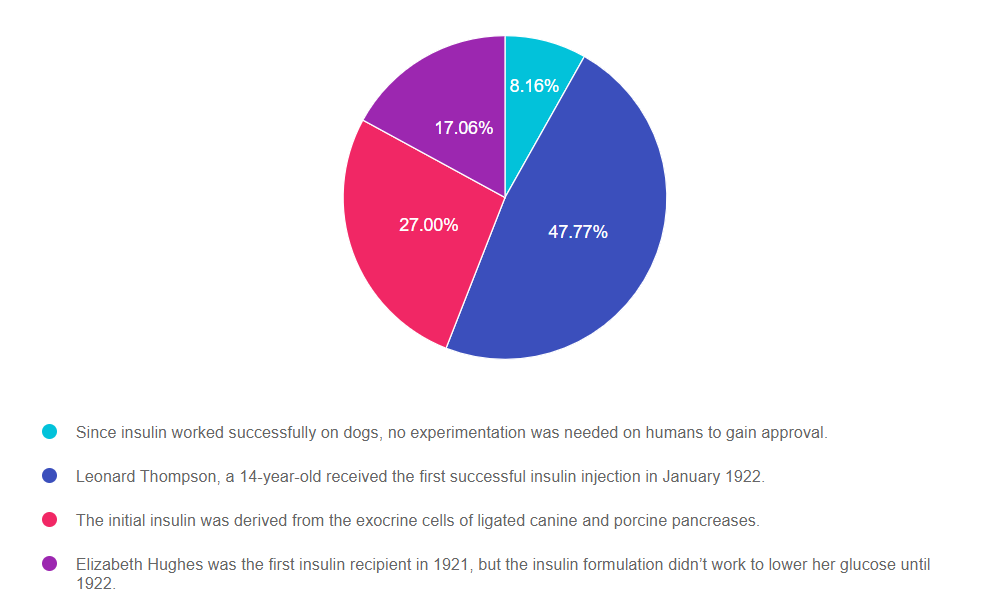
As shown above, the most common choice was option 2, the second most common answer was option 3, then option 4, and finally option 1.
Getting to the Best Answer
If you are thinking about taking the certification exam, this practice test question will set you up for success. Test writers anticipate possible answers based on the details in the question. They will wave those “juicy answers” that seem so familiar to you, right under your nose. Your job is to weed through, eliminate FALSE answers and then choose the BEST answer.
Answer 1 is incorrect. 8.16% chose this answer, “Since insulin worked successfully on dogs, no experimentation was needed on humans to gain approval.” Insulin’s approval was certainly fast tracked, but experiments were conducted on animals first, than humans, before releasing for widespread use and saving the lives of millions.
Answer 2 is correct. 47.77% of you chose this answer, “Leonard Thompson, a 14-year-old received the first successful insulin injection in January 1922.” YES, great job. On January 11, 1922, Leonard Thompson was the first person to receive insulin when he was only 14 years of age. The first injection caused an allergic reaction due to impurities. After James Collip improved the insulin refinement process, the second dose of canine pancreas extract was delivered to the young patient twelve days after the first. Thompson’s health rapidly improved and he lived another 13 years on insulin injections, dying at the young age of 26 due to pneumonia.
Answer 3 is incorrect. 27% of respondents chose this answer, “The initial insulin was derived from the exocrine cells of ligated canine and porcine pancreases.” This is a juicy sounding answer! However, insulin was derived from the endocrine cells of dogs, ox and porcine, to produce insulin; not the exocrine cells that produce digestive enzymes.
Finally, Answer 4 is incorrect. 17.06% chose this answer, “Elizabeth Hughes was the first insulin recipient in 1921 but the insulin formulation didn’t work to lower her glucose until 1922.” Another juicy answer since it has some elements of truth, however Elizabeth was not the first person to receive insulin therapy. Elizabeth developed diabetes in 1918 at age 11 and by the fall of 1922, she weighed only 45 pounds, due to her body’s inability to store energy and the strict 800 calorie diet she followed to prevent ketosis. Elizabeth arrived in Toronto in August 15, 1922 and received insulin injections from Dr. Banting and she recovered rapidly. She returned home to Washington D.C . Thanksgiving Day 1922 on a 2200 calorie meal plan and insulin injections. She lived to the age of 73, and received over 42,000 insulin injections over her lifetime. You can read more in the book, Breakthrough, which chronicles Elizabeth Hughes, the discovery of insulin and the Making of a Medical Miracle.
More Reading on the Discovery of Insulin
The Discovery of Insulin – Vecchio I, Tornali C, Bragazzi NL, Martini M. The Discovery of Insulin: An Important Milestone in the History of Medicine. Front Endocrinol (Lausanne). 2018;9:613. Published 2018 Oct 23. doi:10.3389/fendo.2018.00613
Breakthrough, which chronicles Elizabeth Hughes, the discovery of insulin and the Making of a Medical Miracle.
We hope you appreciate this week’s rationale! Thank you so much for taking the time to answer our Question of the Week and participate in this fun learning activity!
Enroll in our Virtual DiabetesEd Specialist Program!
Did you miss the live conference? No worries!
You can register now to watch on-demand
Click here to learn more and get started!
Whether you are new to diabetes or a seasoned expert, you’ll benefit from this virtual conference with the latest research plus critical content that you can immediately apply to your clinical practice.
If you are seeking a state-of-the-art review of current diabetes care, this course is for you. Our team has been fine-tuning this course for over fifteen years, and we know what you need. This program can also be a great addition to your CDCES or BC-ADM exam study plan.
Team of expert faculty includes:
- Diana Isaacs, PharmD, BCPS, BC-ADM, BCACP, CDCES – Educator of the Year, 2020
- Coach Beverly Thomassian, RN, MPH, CDCES, BC-ADM
- Ashley LaBrier, MS, RD, CDCES, Diabetes Program Coordinator
In addition to informative lectures, we also use group activities and case studies to highlight the essential knowledge, skills, and strategies needed to succeed in diabetes education today!
CEs: Includes over 30 CEs
Program Info: 2021 Diabetes Educator Course Flyer & Schedule (subject to change)
Speakers: View Conference Faculty.
Dates: Your registration fee includes access to FREE podcast and all recorded webinars for one year.
Virtual DiabetesEd Specialist Conference Deluxe | Recorded & Ready for Viewing! | 30+ CEs
Deluxe Virtual Program for $459 includes:
- Presentations by our team of experts
- Q & A Session with the instructor after each webinar
- State-of-the-art review of current diabetes care and technology.
- Resources for each session
- Access to FREE podcast and recorded webinars within a week of each live session for one full year.
+Plus Syllabus, Standards and Swag:
- Diabetes Educator Course 2021 Syllabus Hard Copy – over 100 pages -This spiral-bound workbook contains the printed version of all of the instructor’s slides.
- DiabetesEd Services highlighters, Medication PocketCard and Pen
2021 Diabetes Educator Course Flyer & Schedule (subject to change)
Team of Experts: Our team of expert faculty has been fine-tuning this course for over fifteen years and we know what you need to succeed! In addition to informative lectures, we also use group activities and case studies to highlight the essential knowledge, skills, and strategies needed to succeed in diabetes education today!
Bonus Courses worth 12+ CEs, FREE
When you register for our Virtual Course, you have immediate access to these Bonus DiabetesEd University Online Courses – for FREE!
- Test Taking Toolkit – Over 200 sample test questions!
- Level 2 – Assessing and Promoting Well-Being: From Population Health to a Person-Centered Approach 1.5 CEs
- Level 2 – Hospital and Hyperglycemia 1.5 CEs
- Level 2 – Hyperglycemic Crisis, DKA and HHS Standards 1.0 CEs
- Level 2 – Meds Management Update for Type 2 – 1.5 CEs
- Level 2 – Setting up a Successful Diabetes Program 1.5 CEs
- Level 2 – Pregnancy and Diabetes 1.5 CEs
- Level 2 – From Tots to Teens – Diabetes Standards 1.5 CEs
- Level 2 – Older Adults and Diabetes 1.5 CEs
- Mindfulness and Compassion in the Diabetes Encounter – 1.0 CE
2021 Diabetes Educator Course Flyer & Schedule (subject to change)
Sign up for Diabetes Blog Bytes – we post one daily Blog Byte from Monday to Friday. And of course, Tuesday is our Question of the Week. It’s Informative and FREE! Sign up below!
[yikes-mailchimp form=”1″]Accreditation: Diabetes Education Services is an approved provider by the California Board of Registered Nursing, Provider 12640, and Commission on Dietetic Registration (CDR), Provider DI002. Since these programs are approved by the CDR it satisfies the CE requirements for the CDCES regardless of your profession.*
The use of DES products does not guarantee the successful passage of the CDCES exam. CBDCE does not endorse any preparatory or review materials for the CDCES exam, except for those published by CBDCE.
Rationale of the Week | Best strategy to Prevent Hypo in Hospital?

Our September 28th Question of the week quizzed test takers on the best strategy to prevent hypo in the hospital. 64% of respondents, chose the best answer. We are excited to share info so you can pass on helpful info to people living with diabetes and your hospital colleagues.
Before we start though, if you don’t want any spoilers and haven’t tried the question yet, you can answer below: Answer Question
Question: As a diabetes specialist at a local hospital, one of your quality improvement goals is to prevent nocturnal hypoglycemia.
Which of the of following policy changes would most likely lower rates of overnight and morning hypoglycemia?
Answer Choices:
- Make sure the medication carts are stocked with glucagon rescue kits.
- Eliminate insulin sliding scale and encourage basal insulin therapy.
- Collaborate with dietary to make sure all people with diabetes get protein plus carb snack.
- Implement a plan to decrease basal insulin dose if morning glucose is less than 100 mg/dl.
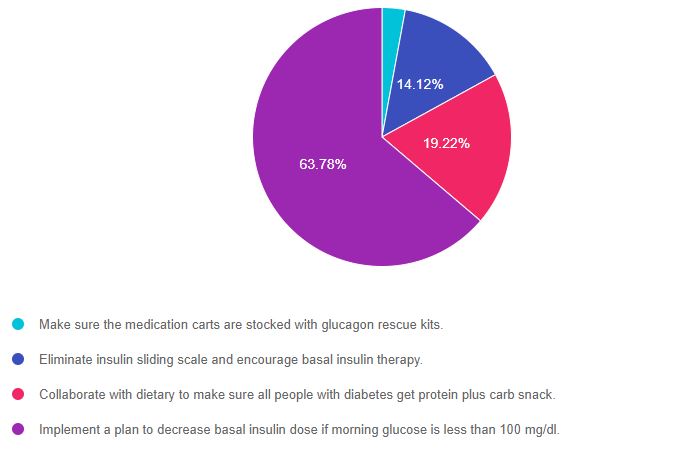
As shown above, the most common choice was option 4, the second most common answer was option 3, then option 2, and finally option 1.
Getting to the Best Answer
If you are thinking about taking the certification exam, it is helpful to know the goals of care and considerations for people with diabetes in the acute care setting. This practice test question will set you up for success. Test writers anticipate possible answers based on the details in the question. They will wave those “juicy answers” that seem so familiar to you, right under your nose. Your job is to weed through the to choose the BEST answer.
Answer 1 is incorrect. 2.88% chose this answer, “Make sure the medication carts are stocked with glucagon rescue kits.” Since the question is asking “what policy changes would most likely lower rates of overnight and morning hypoglycemia“, this is answer does not address the problem in the question; what policy change would PREVENT hypoglycemia. Having glucagon rescue meds would treat hypoglycemia, but not prevent it.
Answer 2 is incorrect. 14.12% of you chose this answer, “Eliminate insulin sliding scale and encourage basal insulin therapy.” It is true that the ADA does not recommend insulin sliding scale for inpatient management of diabetes since it is not an effective way to manage hyperglycemia. In addition, since sliding scale is usually administered with meals, it is not the most likely culprit causing morning hypoglycemia. Generally speaking, too much basal insulin is usually the cause of morning hypoglycemia. So stopping the sliding scale and encouraging basal insulin, is not the BEST answer to address the question and reduce morning hypoglycemia.
Answer 3 is incorrect. 19.22% of respondents chose this answer, “Collaborate with dietary to make sure all people with diabetes get protein plus carb snack.” Studies have shown that providing a carb snack at bedtime can decrease risk of nocturnal and morning hypoglycemia. But, if the basal insulin dose is too much, the person could still experience hypoglycemia, even with a carb snack. P.S, adding protein has not been shown to sustain the action of the carb and enhance hypoglycemia prevention. We never want to “feed” the insulin. We always want to give the least amount of insulin to get glucose to target and keep people safe.
Finally, Answer 4 is correct. 63.78% chose this answer, “Implement a plan to decrease basal insulin dose if morning glucose is less than 100 mg/dl.” YES, this is the BEST Answer. GREAT JOB. To keep inpatients safe, creating a policy that notifies the medical team when the morning glucose level is less than 100 mg/dL coupled with a reduction of basal insulin dose, would be an effective strategy to prevent morning hypoglycemia.
We hope you appreciate this week’s rationale! Thank you so much for taking the time to answer our Question of the Week and participate in this fun learning activity!
Enroll in our Virtual DiabetesEd Specialist Program!
Did you miss the live conference? No worries!
You can register now to watch on-demand
Click here to learn more and get started!
Whether you are new to diabetes or a seasoned expert, you’ll benefit from this virtual conference with the latest research plus critical content that you can immediately apply to your clinical practice.
If you are seeking a state-of-the-art review of current diabetes care, this course is for you. Our team has been fine-tuning this course for over fifteen years, and we know what you need. This program can also be a great addition to your CDCES or BC-ADM exam study plan.
Team of expert faculty includes:
- Diana Isaacs, PharmD, BCPS, BC-ADM, BCACP, CDCES – Educator of the Year, 2020
- Coach Beverly Thomassian, RN, MPH, CDCES, BC-ADM
- Ashley LaBrier, MS, RD, CDCES, Diabetes Program Coordinator
In addition to informative lectures, we also use group activities and case studies to highlight the essential knowledge, skills, and strategies needed to succeed in diabetes education today!
CEs: Includes over 30 CEs
Program Info: 2021 Diabetes Educator Course Flyer & Schedule (subject to change)
Speakers: View Conference Faculty.
Dates: Your registration fee includes access to FREE podcast and all recorded webinars for one year.
Virtual DiabetesEd Specialist Conference Deluxe | Recorded & Ready for Viewing! | 30+ CEs
Deluxe Virtual Program for $459 includes:
- Presentations by our team of experts
- Q & A Session with the instructor after each webinar
- State-of-the-art review of current diabetes care and technology.
- Resources for each session
- Access to FREE podcast and recorded webinars within a week of each live session for one full year.
+Plus Syllabus, Standards and Swag:
- Diabetes Educator Course 2021 Syllabus Hard Copy – over 100 pages -This spiral-bound workbook contains the printed version of all of the instructor’s slides.
- DiabetesEd Services highlighters, Medication PocketCard and Pen
2021 Diabetes Educator Course Flyer & Schedule (subject to change)
Team of Experts: Our team of expert faculty has been fine-tuning this course for over fifteen years and we know what you need to succeed! In addition to informative lectures, we also use group activities and case studies to highlight the essential knowledge, skills, and strategies needed to succeed in diabetes education today!
Bonus Courses worth 12+ CEs, FREE
When you register for our Virtual Course, you have immediate access to these Bonus DiabetesEd University Online Courses – for FREE!
- Test Taking Toolkit – Over 200 sample test questions!
- Level 2 – Assessing and Promoting Well-Being: From Population Health to a Person-Centered Approach 1.5 CEs
- Level 2 – Hospital and Hyperglycemia 1.5 CEs
- Level 2 – Hyperglycemic Crisis, DKA and HHS Standards 1.0 CEs
- Level 2 – Meds Management Update for Type 2 – 1.5 CEs
- Level 2 – Setting up a Successful Diabetes Program 1.5 CEs
- Level 2 – Pregnancy and Diabetes 1.5 CEs
- Level 2 – From Tots to Teens – Diabetes Standards 1.5 CEs
- Level 2 – Older Adults and Diabetes 1.5 CEs
- Mindfulness and Compassion in the Diabetes Encounter – 1.0 CE
2021 Diabetes Educator Course Flyer & Schedule (subject to change)
Sign up for Diabetes Blog Bytes – we post one daily Blog Byte from Monday to Friday. And of course, Tuesday is our Question of the Week. It’s Informative and FREE! Sign up below!
[yikes-mailchimp form=”1″]Accreditation: Diabetes Education Services is an approved provider by the California Board of Registered Nursing, Provider 12640, and Commission on Dietetic Registration (CDR), Provider DI002. Since these programs are approved by the CDR it satisfies the CE requirements for the CDCES regardless of your profession.*
The use of DES products does not guarantee the successful passage of the CDCES exam. CBDCE does not endorse any preparatory or review materials for the CDCES exam, except for those published by CBDCE.
Rationale of the Week | “My life is a mess”

Our October 19th Question of the week quizzed test takers on a person who is clearly in crisis. 36% of respondents, chose the best answer. We feel it is important to share this rationale of the week, so you can advocate for people struggling with mental health while trying to manage their diabetes.
Before we start though, if you don’t want any spoilers and haven’t tried the question yet, you can answer below: Answer Question
Question: JR is 26 years old with newly diagnosed diabetes. JR keeps missing appointments and when you finally get a hold of them on the phone, they start crying and say “my life is a mess”. JR is struggling with addiction, periods of houselessness and extra weight in addition to diabetes.
Based on this information, what is the most likely barrier to JR engaging in self-care?
Answer Choices:
- Adverse Childhood experiences (ACEs)
- JR is struggling with depression
- Diabetes distress is at the core of the listed behaviors
- Grieving and denial of diabetes diagnosis
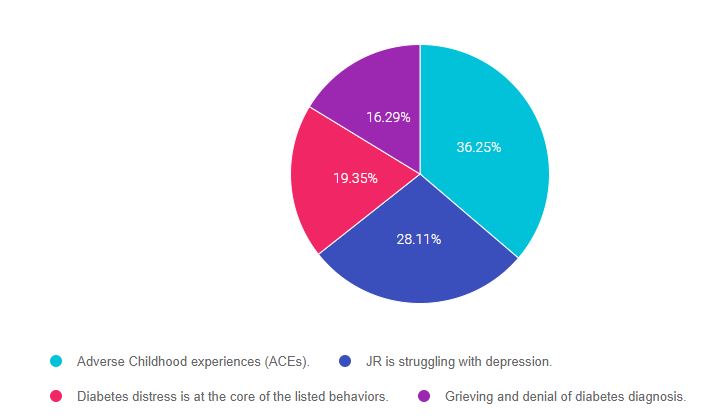
As shown above, the most common choice was option 4, the second most common answer was option 1, then option 2, and finally option 3.
Getting to the Best Answer
If you are thinking about taking the certification exam, it is helpful to know the goals of care and mental health considerations for people with diabetes . This practice test question will set you up for success. Test writers anticipate possible answers based on the details in the question. They will wave those “juicy answers” that seem so familiar to you, right under your nose. Your job is to weed through the to choose the BEST answer.
Answer 1 is correct. 36.25% chose this answer, “Adverse Childhood Experiences (ACEs).” YES, Good job, this is the BEST Answer. JR is missing appointments and when you finally get a hold of them, they say, “my life is a mess”. In addition, we know that JR is struggling with addiction, periods of houselessness and extra weight in addition to diabetes. These are all signs that JR has lived through adverse childhood experiences and toxic stress. By addressing this and providing resources, we can help JR move toward healing. See our ACE Resource page for more info.
Answer 2 is incorrect. 28.11% of you chose this answer, “JR is struggling with depression.” Is this situation, depression can be considered, but we don’t hear the hallmark statements associated with depression – “Loss of pleasure in things that used to bring them joy or feeling down or hopeless”. ACE’s are a better match for what JR is describing. See our Psychosocial Care Resource Page– for articles and screening tools.
Answer 3 is incorrect. 19.35% of respondents chose this answer, “Diabetes distress is at the core of the listed behaviors.” Is this situation, diabetes distress certainly can be considered, but it doesn’t seem to be the driving force behind JR’s struggle with addiction, periods of houselessness and extra weight. Diabetes distress is more heavily associated with diabetes specific related behaviors (fear of hypo, provider doesn’t understand my diabetes, etc.). See our Psychosocial Care Resource Page– for articles and the diabetes distress screening tool.
Finally, Answer 4 is incorrect. 16.29% chose this answer, “Grieving and denial of diabetes diagnosis.” Is this situation, grieving and denial can certainly can be considered, but it doesn’t seem to be the driving force behind JR’s struggle with addiction, periods of houselessness and extra weight. Diabetes denial is more heavily associated with lack of self-care; not checking blood glucose, avoiding medications, eating “whatever”. We don’t hear any of that from this person. The best explanation is that JR has lived through adverse childhood experiences and toxic stress. By addressing this and providing resources, we can help JR move toward healing. See our ACE Resource page for more info.
We hope you appreciate this week’s rationale! Thank you so much for taking the time to answer our Question of the Week and participate in this fun learning activity!
Want to learn about this important topic?
Join Coach Bev for an honest conversation on
The Impact of Adverse Childhood Experiences on Health
Adverse childhood experiences (ACE) are associated with an increased risk of diabetes, heart disease, cancer and a variety of other health consequences for adults. This session reviews how diabetes care and education specialists can provide screening, assessment, and trauma-informed care to individuals who experienced ACEs and are living with toxic stress. We will explore strategies to address ACES and improve outcomes for individuals and communities. Throughout, we will focus on supporting self-care with a focus on recognizing and promoting resilience.
Topics include:
- Discuss the benefits of assessing Adverse Childhood Experiences (ACE) in individuals with diabetes.
- State the relationship between ACE Scores and risk of future health complications.
- Describe a person-centered approach to fostering resilience and self-care for individuals with toxic stress.
- Identify two strategies to provide trauma-informed care in your work setting.
2 Ways to Join the Webinar
This includes access to the recorded version of this webinar on your Online University Student Portal and 1.0 CE.
Intended Audience: This course is a knowledge-based activity designed for individuals or groups of diabetes educators, including RNs, RDs, Pharmacists, Nurse Practitioners, Clinical Nurse Specialists, Physician Assistants, and other health care providers interested in enhancing their diabetes medication knowledge.
Instructor: Beverly Thomassian RN, MPH, CDCES, BC-ADM is a working educator and a nationally recognized diabetes expert.
Sign up for Diabetes Blog Bytes – we post one daily Blog Byte from Monday to Friday. And of course, Tuesday is our Question of the Week. It’s Informative and FREE! Sign up below!
[yikes-mailchimp form=”1″]Accreditation: Diabetes Education Services is an approved provider by the California Board of Registered Nursing, Provider 12640, and Commission on Dietetic Registration (CDR), Provider DI002. Since these programs are approved by the CDR it satisfies the CE requirements for the CDCES regardless of your profession.*
The use of DES products does not guarantee the successful passage of the CDCES exam. CBDCE does not endorse any preparatory or review materials for the CDCES exam, except for those published by CBDCE.








